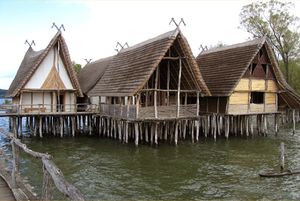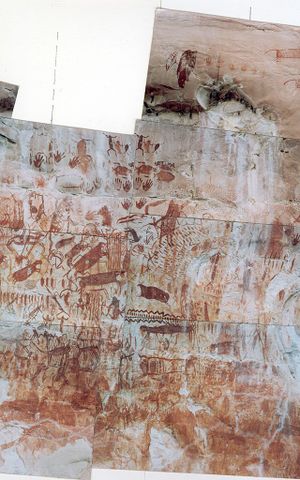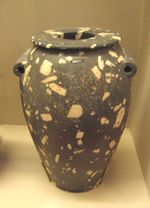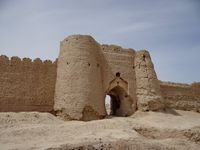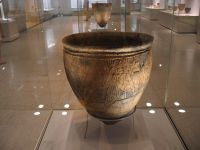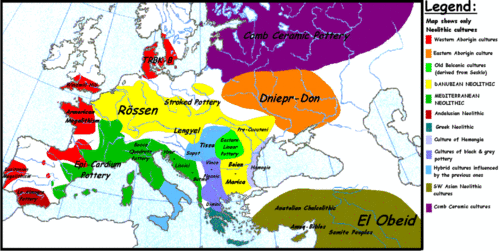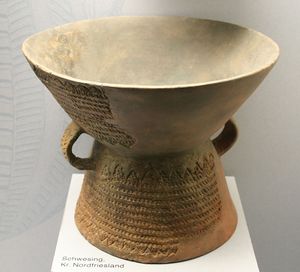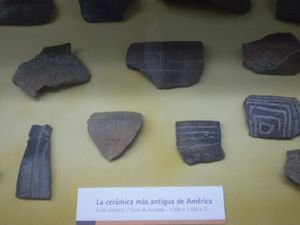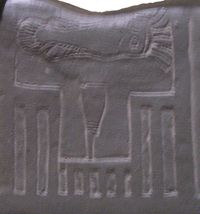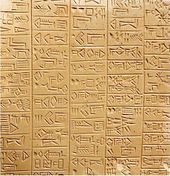الألفية الرابعة ق.م.
| الألفيات: | |
|---|---|
| القرون: |
الألفية الرابعة ق.م. شهدت تغيرات كبرى في الثقافة الإنسانية. مثلت بداية العصر البرونزي وعصر الكتابة.
في هذه الألفية تأسست مدينة سومر ومملكة مصر واحتلت الصدارة. انتشرت الزراعة بشكل كبير عبر أوراسيا. زاد سكان العالم بمقدار الضعف، حيث تضاعف من 7 إلى 14 مليون شخص.
. . . . . . . . . . . . . . . . . . . . . . . . . . . . . . . . . . . . . . . . . . . . . . . . . . . . . . . . . . . . . . . . . . . . . . . . . . . . . . . . . . . . . . . . . . . . . . . . . . . . . . . . . . . . . . . . . . . . . . . . . . . . . . . . . . . . . . . . . . . . . . . . . . . . . . . . . . . . . . . . . . . . . . . .
أحداث
- بلاد الرافدين is in the Uruk period, with emerging Sumerian hegemony and development of "proto-cuneiform" writing; base-60 mathematics, astronomy and astrology, civil law, complex hydrology, the sailboat, potter's wheel and wheel; the Chalcolithic proceeds into the Early Bronze Age.
- ح. 4000 ق.م.—First neolithic settlers in the island of Thera (Santorini), Greece, migrating probably from Minoan Crete.
- ح. 4000 BC—Beaker from Susa (modern Shush, Iran) is made. It is now at Musée du Louvre, Paris.
- ح. 4000 ق.م.–2000 ق.م.—People and animals, a detail of rock-shelter painting in Cogul, Lleida, Spain, are painted. It is now at Museo Arqueológico, Barcelona.
- ح. 3900 ق.م.—5.9 kiloyear event, one of the most intense aridification events during the Holocene. It ended the Neolithic Subpluvial and likely initiated the most recent desiccation of the Sahara desert, triggering migration to river valleys, such as from central North Africa to the Nile valley.
- Babylonian influence predominant in Mediterranean regions of Asia (to 2000 BC)
- In Colombia, circa 3600 BC, first rupestrian art Chiribiquete (Caquetá).
- 3600 ق.م.—Construction of the Ġgantija megalithic temple complex on the Island of Gozo, Malta: the world's oldest extant unburied free-standing structures, and the world's oldest religious structures. (See Göbekli Tepe for older, buried religious structures.)
- 3600–3200 ق.م.—Construction of the first temple within the Mnajdra solar temple complex on Malta, containing "furniture" such as stone benches and tables, that set it apart from other European megalith constructions.
- 3600–3000 ق.م.—Construction of the Ta' Ħaġrat and Kordin III temples on Malta.
- 3500 Metalcasting began in the Mohenjodaro area.
- ح. 3500 ق.م.—Figures of a man and a woman, from Cernavodă, Romania, are made. They are now at National Historical Museum, Bucharest.
- 3500–3400 ق.م.—Jar with boat designs, from Hierakonpolis (today in the Brooklyn Museum) is created. Predynastic Egypt.
- 3500–2340 ق.م.—First cities developed in Southern Mesopotamia. Inhabitants migrated from north.
- The cuneiform script proper emerges from pictographic proto-writing in the later 4th millennium. Mesopotamia's "proto-literate" period spans the 35th to 32nd centuries. The first documents unequivocally written in the Sumerian language date to the 31st century, found at Jemdet Nasr.
- 3300–2900 ق.م.—Construction of the Newgrange solar observatory/passage tomb in Ireland.
- 3300—Bronze Age starts in Indus Valley (Harappa)
- ح. 3300 BC—Ötzi the Iceman dies near the present-day border between Austria and Italy, only to be discovered in 1991 buried in a glacier of the Ötztal Alps. His cause of death is believed to be homicide.
- 3250–3000 ق.م.—Construction of three megalithic temples at Tarxien, Malta.
- 3200–2500 ق.م.—Construction of the Ħaġar Qim megalithic temple complex on Malta, featuring both solar and lunar alignments.
- ح. 3150 ق.م.—Predynastic period ended in Ancient Egypt. Early Dynastic (Archaic) period started (according to French Egyptologist Nicolas Grimal). The period includes 1st and 2nd Dynasties.
- ح. 3150 ق.م. a lesser Tollmann's hypothetical bolide event may have occurred.
- August 11, 3114 BC—start date of the Mayan calendar.
- ح. 3100 ق.م.—According to the legend, Menes unifies Upper and Lower Egypt, and a new capital is erected at Memphis.
- c. 3100 BC—Narmer Palette
- ح. 3100–2600 ق.م.—Neolithic settlement at Skara Brae in the Orkney Islands, Scotland, is inhabited.
- 3051 ق.م. The oldest currently (2013) living non-clonal organism germinated in the Grove of the Ancients.
- First to Fourth dynasty of Kish in Mesopotamia.
- Discovery of silver.
- The beginnings of Iberian civilizations, arrival to the peninsula dating as far back as 4000 BC.
- ح. 3000 ق.م.—First pottery in Colombia at Puerto Hormiga (Magdalena), considered one of the first attempts of pottery of the New World. First settlement at Puerto Badel (Bolívar).
- Sumerian temple of Janna at Eridu erected.
- Temple at Al-Ubaid and tomb of Mes-Kalam-Dug built near Ur, Chaldea.
حضارات
- مصر:
- حضارة نقادة على النيل, 4000 ق.م.–3000 ق.م.. First hieroglyphs appear thus far around 3500 ق.م. as found on labels in a ruler's tomb في أبيدوس.
- الأسرة الأولى (من 3080 ق.م. إلى 2925 ق.م.).
- حضارة المعادي في مصر السفلى (4000-3500 ق.م.).
- النوبة: حوالي 3200 ق.م. خلقت مجتمع منظم، ولكن حتى 2600 ق.م.، تبقى تابعة لـمصر العليا.
- النوبة: المجموعة-أ (3800-3100 ق.م.)
- بلاد الرافدين
- سومر
- فترة العبيد (5500-3500 ق.م.) - العبيد الرابعة (حوالي 3900/3800 ق.م.)
- فترة اوروك (protohistoric سومر) 4100 ق.م.–3100 ق.م.
- اوركش (شمال سوريا) تأسست أثناء fourth millenniحوالي ق.م. possibly by the Hurrians
- فترة گمدت نصر (3100-2900 ق.م.) - اوروك-3
- سومر
- سوريا:
- تل براك (6000-1360 ق.م.)
- مقابر جماعية (3800-3600 ق.م.)
- معبد العيون (Augentempel؛ 3500-3300 ق.م.)
- تل شويرا (5000-1200 ق.م.)
- تل حموقار (4500-2000 ق.م.): دمار ونزاعات مسلحة حوالي 3500 ق.م.
- حبوبة كبيرة (3500-3300 ق.م.) - يحتمل أن يكون منفذ تجاري لأوروك.
- تل براك (6000-1360 ق.م.)
- فلسطين:
- الحضارة الغسولية (4500-3500 ق.م.)
- إيران:
- حضارة جيروفت (4000-1000 ق.م.)
- تپه سيالك 3 (الألفية الخامسة وبداية الرابعة ق.م.)
- گودين تپه 5 (3500-3200 ق.م.)
- تپه سيالك 4 (3500-3000 ق.م.)
- شهر سوخته (3200-2800 ق.م.)
- Proto-Elamite (3200-2700 ق.م.)
- تپه يحيى 6 (4500-3800 ق.م.)
- تپه يحيى 5 (3800-3400 ق.م.)
- تپه يحيى 4 (3400-3000 ق.م.)
- سوسا 1 (4200-3800 ق.م.)
- سوسا 2 (3800-3100 ق.م.)
- حضارة جيروفت (4000-1000 ق.م.)
- وادي السند
- حضارة أمري (الألفيتان الرابعة والثالثة ق.م.)
- أمري 1 (3600-2750 ق.م.)
- حضارة وادي السند
- كاليبانگان 1 (3500-2800 ق.م.)
- كوت ديجي (3400-2650 ق.م.)
- هراپا 1: ناحية راڤي من طور هاكرا (3300-2800 ق.م.)
- حضارة أمري (الألفيتان الرابعة والثالثة ق.م.)
- الصين:
- Dadiwan-Kultur (5800-3000 ق.م.), oberer Gelber Fluss.
- Yangshao-Kultur (5000-2000 ق.م.), mit Hirseanbau, Seidenherstellung und Keramik في وسط وشمال الصين.
- Hongshan-Kultur (4700-2900 ق.م.)، شمال شرق الصين.
- Daxi-Kultur (4400-3300 ق.م.), mittlerer Jangtsekiang.
- Dawenkou-Kultur (4100-2600 ق.م.), mit feiner Keramik, Ackerbau, Viehzucht und Fischfang entlang Gelbem Meer.
- Beiyinyangying-Kultur (4000-3000 ق.م.) am unteren Jangtsekiang.
- Songze-Kultur (3900-3200 ق.م.), unterer Jangtsekiang.
- Miaozigou-Kultur (3500-3000 ق.م.), منغوليا الداخلية.
- Yingpu-Kultur (3500-2000 ق.م.) في تايوان.
- Liangzhu-Kultur (3400/3300-2200 ق.م.) في جنوب شرق الصين.
- Nuomuhong-Kultur (3300-2900 ق.م.), Qaidam-Becken.
- Longshan-Kultur (3200-1850 ق.م.) mit Seidenherstellung und Keramik am mittleren und unteren Gelben Fluss.
- Kharro-Kultur (3200-2000 ق.م.) في الصين والتبت.
- ڤيتنام:
- Đa-Bút-Kultur (4000-1700 ق.م.).
- كوريا:
- Frühe Jeulmun-Zeit (6000-3500 ق.م.).
- Mittlere Jeulmun-Zeit (3500-2000 ق.م.), mit Hirseanbau ab 3100 ق.م..
- اليابان:
- Frühe Jōmon-Zeit (Jōmon III - 4000-3000/2500 ق.م.), erste größere Siedlungen.
- سيبريا:
- Jekaterininka-Kultur (4300-3700 ق.م.), Südwestsibirien.
- Afanassjewo-Kultur im Süden Sibiriens (3500-2500 ق.م.).
- Glaskowo-Kultur (3200-2400 ق.م.).
- قزخستان وشرق اوروپا (روسيا، اوكرانيا):
- Kurgan-Kulturen (5000-3000 ق.م.): Sredny-Stog-Kultur (4500-3500 ق.م.) nördlich des Asowschen Meeres.
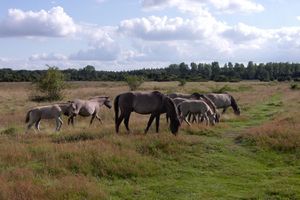
- قزخستان:
- Botai-Kultur (3700-3100 ق.م.). Erstmalige Domestikation des Wildpferds.
- روسيا واوكرانيا:
- Jamnaja-Kultur (3600-2300 ق.م.).
- Fatjanowo-Kultur (3200-2300 ق.م. nach Anthony).[1]
- Kura-Araxes-Kultur (3500/3000-2000/1900 ق.م.) في القوقاز.
- Rumänien, Moldawien, Ukraine:
- Usatovo-Kultur (3300-3200 ق.م.).
- Esero-Kultur (3300-2700/2500 ق.م.) im östlichen Balkan.
- Osteuropa:
- Die Lengyel-Kultur (4900-3950 ق.م.) mit der Jordansmühler Kultur (4300-3900 ق.م.) in Polen und Tschechien verschwindet zu Beginn des Jahrtausends.
- Nordosteuropa:
- Neman-Kultur (7000-3000 ق.م.).
- Narva-Kultur (5300-1750 ق.م.).
- Haffküstenkultur (5300-1750 ق.م.) im Baltikum und in Polen.
- Grübchenkeramische Kultur (4200-2000 ق.م. - Radiokarbonmethode: 5600-2300 ق.م.).
- جنوب اوروپا:
- Donauzivilisation (5000-3500 ق.م.).
- Boian-Kultur في رومانيا وبلغاريا (4300-3500 ق.م.) - Phase IV - Spanţov Phase - 4000-3500 ق.م..
- Cucuteni-Kultur (4800-3200 ق.م.):
- Cucuteni, Phase B bzw. Tripolje, Phase B2/C1 (4000-3500 ق.م.).
- Tripolje Phase C2 (3500-3200 ق.م.).
- Gumelniţa-Kultur (4700-3700 ق.م.):
- Phase Gumelniţa A2 (4500-3950 ق.م.).
- Phase Gumelniţa B1 und B2 (3950-3700 ق.م.).
- Cernavodă-Kultur (4000-3200 ق.م.) في رومانيا، مولداڤيا، اوكرانيا.
- Coţofeni-Kultur (3500-2500 ق.م.) في رومانيا.
- Griechenland - Kykladenkultur (3200-1100 ق.م.), Frühkykladische Phase.
- Kreta - frühminoische Vorpalastzeit gemäß Warren und Hankey (1989) - FM I (3650/3500-3000 ق.م.).[2] Laut Manning (1995) liegt der Beginn des FM I jedoch wesentlich später, nämlich bei 3100/3000 v. Chr;[3] in der niedrigen und in der hohen Datierung erfolgt er bei 3300 ق.م..
- Vučedol-Kultur (3000-2200 ق.م.) في كرواتيا، البوسنة، سلوڤنيا، صربيا، المجر والنمسا.
- غرب اوروپا:
- Chassey-Lagozza-Cortaillod-Kultur (4600-2400 ق.م.).
- Kultur der Unstan Ware (3600/3500-3200 ق.م.) في اسكتلندة.
- حضارة Grooved Ware في بريطانيا العظمى وأيرلندة (3400-2000 ق.م.).
- Skara Brae من اوركني-Inseln (في 3180 ق.م.-2500 ق.م.).
- Peterborough Ware (3400-2500 ق.م.) في بريطانيا العظمى.
- Megalithkulturen:
- فرنسا (4700 حتى 2000 ق.م.).
- شبه جزيرة أيبريا:
- سردينيا: Ozieri-Kultur (4000-3200 ق.م.).
- مالطا:
- Żebbuġ-Phase (4100-3800 ق.م.).
- Mġarr-Phase (3800-3600 ق.م.).
- Ġgantija-Phase der Tempelperiode (3600-3300/3000 ق.م.).
- Saflieni-Phase (3300-3000 ق.م.) - Nordtempel von Ħaġar Qim (3600-3000 ق.م.) mit solaren und lunaren Ausrichtungen, Tempel von Tarxien (3250-3000 ق.م.).
- Almeríakultur in Südspanien (ab 3500/3400-2400/2000 ق.م.).[4]
- إنگلترة: In Stonehenge 1 wird der Erdwall um 3100 ق.م. ausgehoben.
- وسط اوروپا:
- Michelsberger Kultur (4400-3500 ق.م.) in Frankreich und in Südwestdeutschland.
- Gaterslebener Kultur (4300-3900 ق.م.).
- Rössener Kultur (4300-3500 ق.م.).
- Trichterbecherkultur (nördliches Mitteleuropa) (4200-2800 ق.م.).
- Wangels-Phase (4200-3900 ق.م.).
- Siggenebben-Phase (3900-3700 ق.م.).
- Satruper Stufe (3700-3500 ق.م.).
- Fuchsbergstufe (3500-3300 ق.م.).
- Nordisches Mittelneolithikum MN A I-MN A V (3300-2800 ق.م.) – megalithisch.
- Pfyner Kultur (3900-3500 ق.م.) im Alpenvorland.
- Altheimer Gruppe - Bayern (3800-3400/3300 ق.م.).
- Baalberger Kultur (3800-3400 ق.م.).
- Mondseekultur - Salzkammergut (3770-3200 ق.م.).
- Badener Kultur - Mittlerer Donauraum - Früheste Boleraz (3517-3373 ق.م.).
- Horgener Kultur (3500-2800 ق.م.) in der Schweiz und in Südwestdeutschland.
- Chamer Kultur - Bayern, Tschechien, Österreich (3500-2700 ق.م.).
- Wartberg-Kultur in Nordhessen (3500-2800 ق.م.).
- Salzmünder Gruppe (3400-3000 ق.م.) in Deutschland.
- Remedello-Kultur (3400-2400 ق.م.) in Norditalien.
- Vlaardingen-Kultur (3350-1950 ق.م.) in den Niederlanden.
- Walternienburg-Bernburger Kultur (3200-2800 ق.م.).
- Havelländische Kultur (3200-2800 ق.م.) in Ostdeutschland.
- Gaudo-Kultur (3150-2300 ق.م.) in Süditalien.
- Kugelamphoren-Kultur (3100-2700 ق.م.) (reichte-in die Ukraine).
- Seine-Oise-Marne-Kultur (3100-20000 ق.م.) in Nordfrankreich und Belgien.
- شمال اوروپا:
- Bootaxtkultur (4200-2000 ق.م.) in Skandinavien und im Baltikum.
- Nord- und Mesoamerika:
- Archaische Periode. Ab 4000 ق.م. Errichtung von Mounds in den östlichen Waldgebieten.
- أمريكا الجنوبية:
- Ecuador: Valdivia-Kultur (3950-1750 ق.م.).
- Peru: Norte-Chico-Kultur (3500-1800 ق.م.).
- Kolumbien: San-Agustín-Kultur (3300 ق.م.-1550 n. Chr.).
- أوروپا في العصر الحجري الحديث وغرب أوراسيا
- كريت: بزوغ حضارة مينوا.
- حضارة يمنا ("حضارة كورگان")، تلي حضارة سردني ستوگ هي محل Proto-Indo-Europeans حسب فرضية كورگان
- Pit Grave ("حضارة كورگان")، تلي حضارة سردني ستوگ هي محل Proto-Indo-Europeans according to the Paleolithic Continuity Theory
- حضارة مايكوپ في القوقاز، المعاصرة لـحضارة كورگان، is a candidate for the origin of bronze production and thus the العصر البرونزي.
- حضارة ڤينكا
- Afanasevo 3500 ق.م.—2500 ق.م.، سيبريا، منغوليا، شينجيانگ، قزخستان - آخر العصر النحاسي ومطلع العصر البرونزي.
- Yamna/Kurgan 3500 ق.م.-2300 ق.م.، Pontic-Caspian (شرق البحر الأسود).
- Kura-Araxes 3400 ق.م.–2000 ق.م. - earliest evidence found في سهل أرارات
- أوروپا
- The Trypillian culture has cities with 15,000 citizens, eastern Europe, 5500 ق.م.–2750 ق.م..
- The Funnelbeaker culture, Scandinavia, 4000 ق.م.–2700 ق.م.، originated in southern parts of Europe and slowly advanced up through today's Uppland.
. . . . . . . . . . . . . . . . . . . . . . . . . . . . . . . . . . . . . . . . . . . . . . . . . . . . . . . . . . . . . . . . . . . . . . . . . . . . . . . . . . . . . . . . . . . . . . . . . . . . . . . . . . . . . . . . . . . . . . . . . . . . . . . . . . . . . . . . . . . . . . . . . . . . . . . . . . . . . . . . . . . . . . . .
تغيرات بيئية
| حقبة الهولوسين |
|---|
| ↑ پلايستوسين |
| هولوسين/أنثروپوسين |
|
Based on studies by glaciologist Lonnie Thompson, professor at Ohio State University and researcher with the Byrd Polar Research Center, a number of indicators shows there was a global change in climate 5,200 years ago, probably due to a drop in solar energy output as hypothesized by Ohio State University.[5]
- Plants buried in the Quelccaya Ice Cap in the Peruvian Andes demonstrate the climate had shifted suddenly and severely to capture the plants and preserve them until now.[6]
- A man trapped in an Alpine glacier ("Ötzi the Iceman") is frozen until his discovery in 1991.[7]
- Tree rings from Ireland and England show this was their driest period.[7]
- Ice core records showing the ratio of two oxygen isotopes retrieved from the ice fields atop Africa's Mount Kilimanjaro, a proxy for atmospheric temperature at the time snow fell.[7]
- Major changes in plant pollen uncovered from lakebed cores in South America.[7]
- Record lowest levels of methane retrieved from ice cores from Greenland and Antarctica.[7]
- End of the Neolithic Subpluvial, start of desertification of Sahara (35th century BC). North Africa shifts from a habitable region to a barren desert.[7]
مشاهير الألفية
- أوتسي، رجل الثلج، الرجل من جبال الألپ (حوالي 3340 ق.م.)
- فو شي (صينية: 伏羲؛ پنين: Fú Xī�), Urkaiser Chinas الأسطوري (geboren 3322 ق.م.).
- كريشنا (18 يوليو 3228 ق.م. حتى 17/ 18 فبراير 3102 ق.م.)
- أول حكام لمصر القديمة - بعضهم تواريخهم غير أكيدة:
- الأسرة 00:
- Pen-abu (حوالي 3300 ق.م.)
- الملك الثور (حوالي 3250 ق.م.)
- عقرب الأول (حوالي 3250 ق.م.)
- الأسرة 0:
- Hedju-Hor (حوالي 3200/3150 ق.م.)
- Ni-Hor (حوالي 3220 حتى 3175 ق.م.)
- الصقر المزدوج (حوالي 3230/3100 ق.م.)
- Hat Hor (حوالي 3210/3100 ق.م.)
- الملك التمساح (حوالي 3160/3100 ق.م.)
- عقرب الثاني (حوالي 3025 ق.م.، ولكن أيضاً يؤرخ إلى حوالي 3200 أو 3100 ق.م.[8])
- كا (حوالي 3020 ق.م.، ولكن أيضاً حوالي 3125 ق.م.)
- الأسرة الأولى:
- نعرمر (حوالي 3100/3000 ق.م.[9]، ولكن أيضاً 3185/3150 حتى 3125 ق.م.[10])
- حور آحا (3000 حتى 2980 ق.م.[11]، أيضاً 3125 حتى 3100 ق.م.)
- دجر (2980 حتى 2960 ق.م.، أيضاً 3100 حتى 3055 ق.م.)
- ودجي (2960 حتى 2930 ق.م.، أيضاً 3055 حتى 3050 ق.م.)
- Meritneith – زوجة ودجي
- دن (2930 حتى 2910 ق.م., 3050 حتى 2995 ق.م.)
- ملوك مصر السفلى:
- الأسرة 00:
اختراعات، اكتشافات، وأطروحات

- ح. 4000 ق.م.—potter's wheel in Sumer.[12]
- 4000 ق.م.—Susa is a center of pottery production.
- ح. 4000 ق.م.—Horses are domesticated in Ukraine.
- 3500 ق.م.—2340 ق.م.؛ سومر: wheeled carts, potter's wheel, White Temple ziggurat, bronze tools and weapons.
- ح. 3250 ق.م.—potter's wheel appears in Ancient Near East.
- 3000 ق.م.—Tin is in use in Mesopotamia soon after this time.[13]
- Beginnings of urbanisation in Mesopotamia in Sumer and Egypt.
- First writings in the cities of Uruk and Susa (cuneiform writings). Hieroglyphs in Egypt.
- Kurgan culture of what is now Southern Russia and Ukraine; possibly the first domestication of the horse.
- Sails used in the Nile.
- Construction in England of the Sweet Track, the World's first known engineered roadway.
- Drainage and Sewage collection and disposal created in the Indus Valley civilization.
- Dams, canals, stone sculptures using inclined plane and lever in Sumer.
- Copper was in use, both as tools and weapons.
- Bronze was in use, specifically by the Maykop culture.
- Mastabas, the predecessors of the Egyptian pyramids.
- The earliest phase of the Stonehenge monument (a circular earth bank and ditch) dates to c. 3100 BC.
- The Céide Fields in Ireland, arguably the oldest field system in world, are developed.
- Sumerian writing, done on clay tablets, shows about 2,000 pictographic signs
- White painted pottery in Egypt and southeastern Europe
- Harps and flutes played in Egypt
- Copper alloys used by Egyptians and Sumerians; smelting of gold and silver known.
- Lyres and double clarinets (arghul, mijwiz) played in Egypt
- Earliest known numerals in Egypt
- Linen is produced in the Middle East
الدين
- Sri Krishna and Mahabharata[14][15]
- Antediluvian biblical characters, including Adam, Cain, Enoch, Methuselah, and Noah[16][unreliable source?]
تقاويم وتأريخات

- The Maya calendar dates the creation of the Earth to August 11 or August 13, 3114 BC (establishing that date as day zero of the Long Count 13.0.0.0.0).
- حسب حسابات أريابهاتا (القرن السادس)، فإن كالي يوگا الهندوسية قد بدأت في منتصف الليل (00:00) في 18 فبراير 3102 ق.م. وبالتالي، فإن أريابهاتا يؤرخ أحداث مهابهاراتا إلى حوالي 3137 ق.م.
- 7 أكتوبر 3761 ق.م.—Epoch of the Hebrew Calendar (introduced in the 12th century)
- 3929 ق.م.—Date of creation according to John Lightfoot based on the Old Testament of the Bible, and often associated with the Ussher chronology.
- 1 يناير 4000 ق.م. - Epoch of the Masonic calendar's Anno Lucis era.
قرون
- القرن 40 ق.م.
- القرن 39 ق.م.
- القرن 38 ق.م.
- القرن 37 ق.م.
- القرن 36 ق.م.
- القرن 35 ق.م.
- القرن 34 ق.م.
- القرن 33 ق.م.
- القرن 32 ق.م.
- القرن 31 ق.م.
المصادر
- ^ , ISBN 978-0-691-05887-0
- ^ , ISBN 0-906515-67-X
- ^
- ^
- ^ Major Climate Change Occurred 5,200 Years Ago: Evidence Suggests That History Could Repeat Itself at the Internet Archive
- ^ DOI:10.1073/pnas.0603900103
This citation will be automatically completed in the next few minutes. You can jump the queue or expand by hand - ^ أ ب ت ث ج ح "Major Climate Change Occurred 5,200 Years Ago: Evidence Suggests That History Could Repeat Itself". Science Daily. Retrieved 19 December 2010.
- ^
- ^ , ISBN 88-06-13913-4
- ^ , ISBN 88-452-5531-X
- ^
- ^ Federico Lara Peinado, Universidad Complutense de Madrid: "La Civilización Suemria.". Historia 16, 1999.
- ^ Roberts, J: "History of the World.". Penguin, 1994.
- ^ See horoscope number 1 in Dr. B.V. Raman (1991). Notable Horoscopes. Delhi, India: Motilal Banarsidass. ISBN 81-208-0901-7.
- ^ Arun K. Bansal's research published in Outlook India, September 13, 2004. "Krishna (و. July 21, 3228 BC)".
- ^ Annals of the World, as well as the above sources
